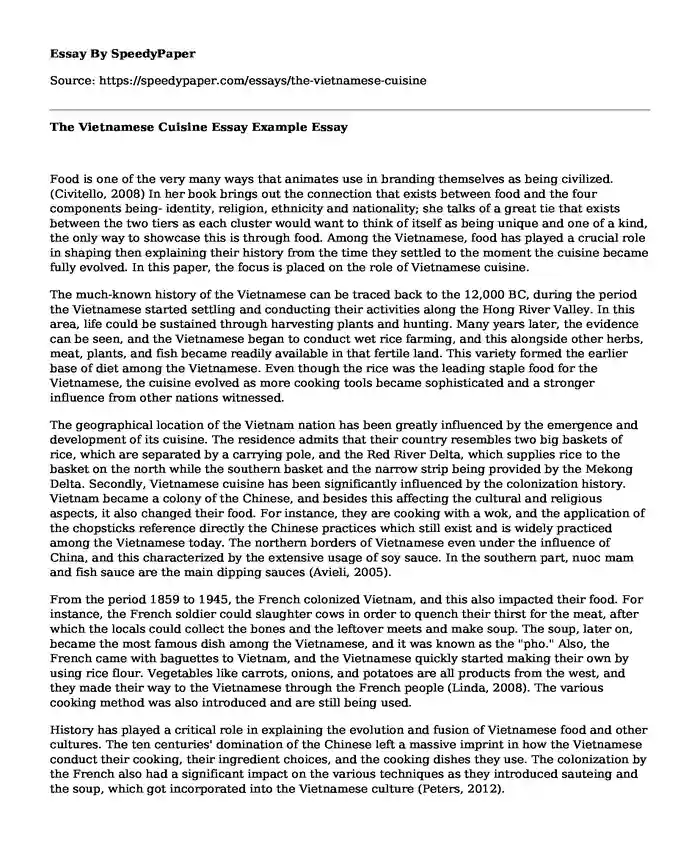Food is one of the very many ways that animates use in branding themselves as being civilized. (Civitello, 2008) In her book brings out the connection that exists between food and the four components being- identity, religion, ethnicity and nationality; she talks of a great tie that exists between the two tiers as each cluster would want to think of itself as being unique and one of a kind, the only way to showcase this is through food. Among the Vietnamese, food has played a crucial role in shaping then explaining their history from the time they settled to the moment the cuisine became fully evolved. In this paper, the focus is placed on the role of Vietnamese cuisine.
The much-known history of the Vietnamese can be traced back to the 12,000 BC, during the period the Vietnamese started settling and conducting their activities along the Hong River Valley. In this area, life could be sustained through harvesting plants and hunting. Many years later, the evidence can be seen, and the Vietnamese began to conduct wet rice farming, and this alongside other herbs, meat, plants, and fish became readily available in that fertile land. This variety formed the earlier base of diet among the Vietnamese. Even though the rice was the leading staple food for the Vietnamese, the cuisine evolved as more cooking tools became sophisticated and a stronger influence from other nations witnessed.
The geographical location of the Vietnam nation has been greatly influenced by the emergence and development of its cuisine. The residence admits that their country resembles two big baskets of rice, which are separated by a carrying pole, and the Red River Delta, which supplies rice to the basket on the north while the southern basket and the narrow strip being provided by the Mekong Delta. Secondly, Vietnamese cuisine has been significantly influenced by the colonization history. Vietnam became a colony of the Chinese, and besides this affecting the cultural and religious aspects, it also changed their food. For instance, they are cooking with a wok, and the application of the chopsticks reference directly the Chinese practices which still exist and is widely practiced among the Vietnamese today. The northern borders of Vietnamese even under the influence of China, and this characterized by the extensive usage of soy sauce. In the southern part, nuoc mam and fish sauce are the main dipping sauces (Avieli, 2005).
From the period 1859 to 1945, the French colonized Vietnam, and this also impacted their food. For instance, the French soldier could slaughter cows in order to quench their thirst for the meat, after which the locals could collect the bones and the leftover meets and make soup. The soup, later on, became the most famous dish among the Vietnamese, and it was known as the "pho." Also, the French came with baguettes to Vietnam, and the Vietnamese quickly started making their own by using rice flour. Vegetables like carrots, onions, and potatoes are all products from the west, and they made their way to the Vietnamese through the French people (Linda, 2008). The various cooking method was also introduced and are still being used.
History has played a critical role in explaining the evolution and fusion of Vietnamese food and other cultures. The ten centuries' domination of the Chinese left a massive imprint in how the Vietnamese conduct their cooking, their ingredient choices, and the cooking dishes they use. The colonization by the French also had a significant impact on the various techniques as they introduced sauteing and the soup, which got incorporated into the Vietnamese culture (Peters, 2012).
In conclusion, Vietnamese cuisine remains one of the most celebrated cuisines all over the world as it combines the arrays of herbs, vegetables, and meat, which are crucial in coming up with the best meal. The cuisine has discussed been significantly influenced by their history and colonizers. The cuisine is more popular due to the rise and development of a more health-conscious society.
Reference
Avieli, N. (2005). Vietnamese New Year rice cakes: Iconic festive dishes and contested national identity. Ethnology, 167-187. Retrieved from https://www.jstor.org/stable/3773995
b-ok.cc/book/554546/935ef6
Civitello, Linda (2008). Cuisine and Culture: A History of Food and People. Hoboken, New Jersey: John Wiley & Sons, Inc. Retrieved from
Peters, E. J. (2012). Cuisine and social status among urban Vietnamese, 1888-1926. The Reinvention of Distinction (pp. 43-57). Springer, Dordrecht. Retrieved from https://link.springer.com/chapter/10.1007/978-94-007-2306-1_3
Cite this page
The Vietnamese Cuisine Essay Example. (2022, Feb 22). Retrieved from https://speedypaper.com/essays/the-vietnamese-cuisine
Request Removal
If you are the original author of this essay and no longer wish to have it published on the SpeedyPaper website, please click below to request its removal:
- Free Essay on Treblinka Concentration Camp
- Free Essay Sample on Industrial Revolution in Great Britain
- Multinationals Essay Example
- Free Essay on the Role of a Chief Financial Officer Research
- Free Essay Sample on the Personal Growth for the Counselor
- Essay Example - The Moral Basis for the Decision
- Paper Example: How to Make a Choice Based on the Best Welfare for the Child?
Popular categories





